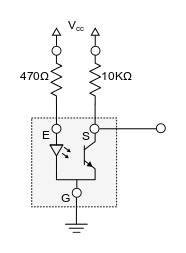chucketn
Senior Citizen
I have a small DC motor that was removed from an old Lexmark Laser Printer Tray. The motor has what looks like a optical or IR emitter/detector under a plastic cover on one end. The motor has a disk on the shaft with small holes in it which is positioned so that the Emitter/detector straddles it.
I want to hack the circuit for the emitter/detector, but it is not marked to identify it. How do I figure out it's properties and circuit requirements?
It has 3 wires, and I have used a multimeter To measure resistance between the leads.
Once I figure out the electrical characteristics I want to use an Arduino Uno to experiment with it.
Chuck
I want to hack the circuit for the emitter/detector, but it is not marked to identify it. How do I figure out it's properties and circuit requirements?
It has 3 wires, and I have used a multimeter To measure resistance between the leads.
Once I figure out the electrical characteristics I want to use an Arduino Uno to experiment with it.
Chuck







































































